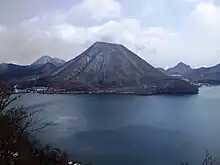Mount Haruna
Mount Haruna (榛名山, Haruna-san) is a dormant stratovolcano in Gunma Prefecture, in the Kantō region of eastern Honshū, Japan.
| Mount Haruna | |
|---|---|
| 榛名山 | |
 Haruna volcano from the east | |
| Highest point | |
| Elevation | 1,449 m (4,754 ft) |
| Coordinates | 36°28′37″N 138°52′41″E |
| Geography | |
| Geology | |
| Mountain type | Stratovolcano |
| Last eruption | 550 CE ± 10 years |
Outline
Mount Haruna started to form more than 300,000 years ago and the last known eruption was 550 AD.[1] The volcano has a summit caldera containing the symmetrical cinder cone of Mount Haruna-Fuji, along with a crater lake, Lake Haruna, along the western side.[1] To the west of the lake is Mount Kamonga, the tallest of Mount Haruna's numerous peaks at 1,449 meters (4,754 ft) high.

The lake and the area to its east, as well as the southern and southwestern slopes, lie within the borders of Takasaki city. The border of Shibukawa city (to the east) nearly approaches Lake Haruna. Both Shinto village and Yoshioka town are on the southeast slopes of the mountain. The northern and northwestern slopes lie within Higashi Agatsuma town, which also bounds Lake Haruna. The summit lies on the border of Takasaki and Higashi Agatsuma.
Mount Haruna, along with Mount Akagi and Mount Myōgi, is one of the "Three Mountains of Jōmō." (Jōmō is an old name for Gunma.)
In popular culture
The Japanese battlecruiser/Battleship Haruna was named after the Mount Haruna. The mountain was made famous in the manga series Initial D under the fictional name Akina (秋名), where the main character, Takumi Fujiwara, delivers tofu every day to a hotel uphill, and back down using his father's highly modified Toyota Sprinter Trueno (AE86). It is also where Takumi won his first few races. It is the home course for the racing team called the Akina Speed Stars with which Takumi becomes closely associated. Later in the anime Takumi due to his unbeatable track records and for his downhill driving technique, is popularly referred to as 'Akina's 86'.
The mountain is featured in the PlayStation 2 games Kaido Battle, Kaido Battle 2: Chain Reaction and Kaido: Touge no Densetsu. It is also featured in the PC games Race Driver: GRID and Blur, although not realistically.
Gallery
 Relief Map
Relief Map Mountaintop
Mountaintop Haruna Volcano (Bottom) from the S.
Haruna Volcano (Bottom) from the S. Mount Kamonga
Mount Kamonga Harunasan Ropeway on Haruna-fuji Lava Dome
Harunasan Ropeway on Haruna-fuji Lava Dome
Climate
| Climate data for Mount Haruna, 1991−2020 normals | |||||||||||||
|---|---|---|---|---|---|---|---|---|---|---|---|---|---|
| Month | Jan | Feb | Mar | Apr | May | Jun | Jul | Aug | Sep | Oct | Nov | Dec | Year |
| Average precipitation mm (inches) | 40.9 (1.61) |
39.8 (1.57) |
84.0 (3.31) |
124.9 (4.92) |
172.1 (6.78) |
285.4 (11.24) |
313.7 (12.35) |
381.3 (15.01) |
359.5 (14.15) |
196.7 (7.74) |
66.0 (2.60) |
33.5 (1.32) |
2,097.6 (82.58) |
| Average precipitation days (≥ 1.0 mm) | 5.3 | 5.8 | 9.4 | 10.5 | 11.9 | 16.1 | 18.3 | 17.4 | 16.5 | 12.1 | 6.9 | 5.4 | 135.6 |
| Source: Japan Meteorological Agency[2] | |||||||||||||
See also
- List of volcanoes in Japan
- The World War II-era battleship Haruna and the recently decommissioned JMSDF destroyer Haruna were named after the mountain.
- Haruna, Gunma
- Haruna Shrine
- Harunasan Ropeway
- Initial D
References
- "Harunasan". Global Volcanism Program. Smithsonian Institution. Retrieved 2021-06-24.
- 榛名山 平年値(年・月ごとの値) 詳細(降水量). JMA. Retrieved February 25, 2022.
External links
- Harunasan - Japan Meteorological Agency (in Japanese)
- "Harunasan: National catalogue of the active volcanoes in Japan" (PDF). - Japan Meteorological Agency
- Haruna San - Geological Survey of Japan
